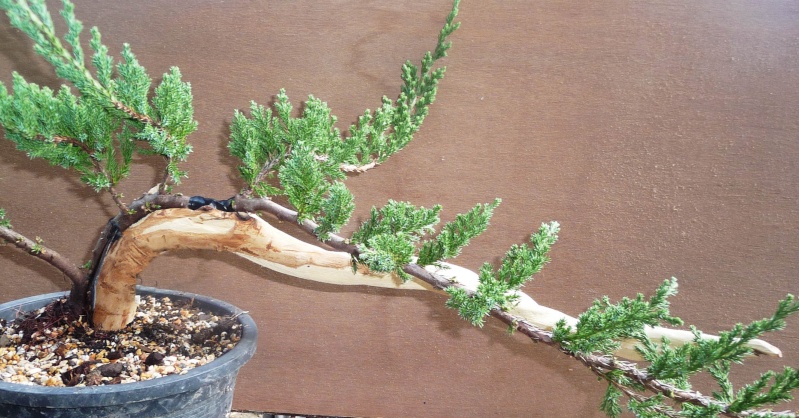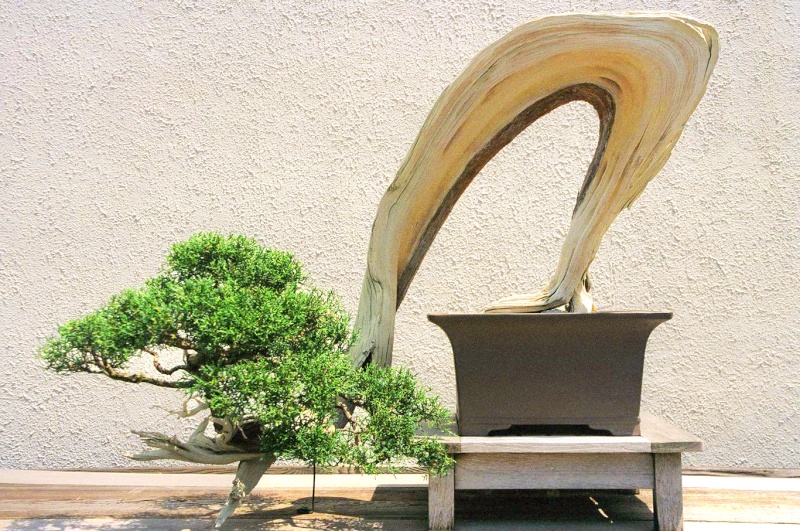deadwood (not part of living tree) basics
4 posters
Page 1 of 1
 deadwood (not part of living tree) basics
deadwood (not part of living tree) basics

i'm working on a design using some dead wood (from a recently chopped down tamarind tree) against a juniper
what should i do with the deadwood to stop it rotting away and keep it looking nice?
i already soaked it in wood preservative to stop termites and stuff. i realize that's very poisonous but if i don't use it, i doubt the wood will last long.
do you think i should varnish it or do some other wood treatment?
by the way, i don't plan on putting the wood underground, it will stop at the soil level.
thanks, steve
steve-thailand- Member
 wood treatment
wood treatment
The only way to completely stop wood from decaying naturally is to isolate if from the natural world, ie a physical barrier such as an expoxy resin, though this would be unsightly! I suppose you could apply a very thin layer of clear epoxy, then gently de-buff it with some ultra-fine sand paper to give it a matt finish? seems like a lot of work though! But as the bonsai will be constantly changing, would you really want something so static entwined with it? If it aged with the tree it would look more natural  but that's just my opinion
but that's just my opinion 
Im genuinely intrigued here, are you trying to grow the tree over the dead wood eventually?
Im genuinely intrigued here, are you trying to grow the tree over the dead wood eventually?

DuncanJH- Member
 Re: deadwood (not part of living tree) basics
Re: deadwood (not part of living tree) basics
DuncanJH wrote:
Im genuinely intrigued here, are you trying to grow the tree over the dead wood eventually?
If the dead wood is tamarind and the living plant is juniper, then it's a "Tanuki".
If tamarind wood is harder than juniper wood, it can be a good technique.
From Wikipedia:
Tamarind wood is a bold red color. Due to its density and durability, tamarind heartwood can be used in making furniture and wood flooring.

AlainK- Member
 Re: deadwood (not part of living tree) basics
Re: deadwood (not part of living tree) basics
thanks, i didn't know that, i'll do some research on Tanuki
i love designs like this

and figure you can get something like this with a younger tree and some creative wood carving
from wikipedia
'Tanuki
A Tanuki-style tree at a bonsai show.
In tanuki bonsai, a living tree is joined to an interesting piece of deadwood to create a composite in the driftwood style. The deadwood usually has the form of a weathered tree trunk, or at least its lower portion. To add living material to the deadwood, a groove or channel is first carved into it. The living tree (usually a young juniper, because of the species' vigor, flexibility, and ability to endure harsh shaping) is fixed within the channel using non-reactive nails or screws, wire wrappings, or clamps. Over time, the young tree grows into the deadwood channel, which disguises the fact that it is a separate entity. Once firmly in place, the nails, screws, or other affixing devices are removed, and the living tree is cultivated and shaped with typical bonsai techniques.
Real driftwood-style bonsai are usually not grown from the common bonsai source materials, but instead are specimens taken from the wild, and are prized but very rare. The tanuki process makes it possible to generate a driftwood-style product from much more common materials. Whether that product can be considered a traditional bonsai is open to question, as implied by the Japanese name for this technique. In Japanese folklore, tanuki (狸?, alternatively タヌキ), the Japanese raccoon dog, are shape-changing tricksters. Tanuki bonsai are sometimes known by the less-demeaning term "Phoenix Grafts" in the West, and many bonsai growers outside Japan consider tanuki an acceptable bonsai technique. But this technique is not currently an accepted part of the Japanese bonsai tradition, and tanuki would not be displayed at a formal Japanese bonsai show.'
steve
i love designs like this

and figure you can get something like this with a younger tree and some creative wood carving
from wikipedia
'Tanuki
A Tanuki-style tree at a bonsai show.
In tanuki bonsai, a living tree is joined to an interesting piece of deadwood to create a composite in the driftwood style. The deadwood usually has the form of a weathered tree trunk, or at least its lower portion. To add living material to the deadwood, a groove or channel is first carved into it. The living tree (usually a young juniper, because of the species' vigor, flexibility, and ability to endure harsh shaping) is fixed within the channel using non-reactive nails or screws, wire wrappings, or clamps. Over time, the young tree grows into the deadwood channel, which disguises the fact that it is a separate entity. Once firmly in place, the nails, screws, or other affixing devices are removed, and the living tree is cultivated and shaped with typical bonsai techniques.
Real driftwood-style bonsai are usually not grown from the common bonsai source materials, but instead are specimens taken from the wild, and are prized but very rare. The tanuki process makes it possible to generate a driftwood-style product from much more common materials. Whether that product can be considered a traditional bonsai is open to question, as implied by the Japanese name for this technique. In Japanese folklore, tanuki (狸?, alternatively タヌキ), the Japanese raccoon dog, are shape-changing tricksters. Tanuki bonsai are sometimes known by the less-demeaning term "Phoenix Grafts" in the West, and many bonsai growers outside Japan consider tanuki an acceptable bonsai technique. But this technique is not currently an accepted part of the Japanese bonsai tradition, and tanuki would not be displayed at a formal Japanese bonsai show.'
steve
steve-thailand- Member
 Re: deadwood (not part of living tree) basics
Re: deadwood (not part of living tree) basics
Ah thank-you AlainK for clearing that up!
Steve, I have seen that exact picture many times and think it is truly amazing! If that is your inspiration then I really do hope we get to see the fruits of your labour in the years to come A thought that occurred to me after my last post was that if your climate happens to be hot and dry, the dead wood would probably last much better than here in Wales, where much of the material I've seen tends to turn green and look rotten, rather than the beautiful bleached white wood of the last picture
A thought that occurred to me after my last post was that if your climate happens to be hot and dry, the dead wood would probably last much better than here in Wales, where much of the material I've seen tends to turn green and look rotten, rather than the beautiful bleached white wood of the last picture 
Thank-you for opening a new world of possibility to me, my mind is racing now!
Duncan
Steve, I have seen that exact picture many times and think it is truly amazing! If that is your inspiration then I really do hope we get to see the fruits of your labour in the years to come
Thank-you for opening a new world of possibility to me, my mind is racing now!
Duncan

DuncanJH- Member
 deadwood basics
deadwood basics
steve if you are going to do do tanuki get a nicer piece of deadwood that ones a bit boring . as for preservative for junipers the deadwood looks better white, so use lime sulpher and if you want mix a little white paint with it, you can get lime sulpher mail order from bangkok tel 0816286127 . if its on broadleaf trees a more natural look is better so use teak oil < homepro> or acrilic water repellant for bricks works ok but get the matt one . regards john
john5555leonard- Member
 Re: deadwood (not part of living tree) basics
Re: deadwood (not part of living tree) basics
john5555leonard wrote:steve if you are going to do do tanuki get a nicer piece of deadwood that ones a bit boring . as for preservative for junipers the deadwood looks better white, so use lime sulpher and if you want mix a little white paint with it, you can get lime sulpher mail order from bangkok tel 0816286127 . if its on broadleaf trees a more natural look is better so use teak oil < homepro> or acrilic water repellant for bricks works ok but get the matt one . regards john
thanks, great ideas. i have some teak oil here, i'll try it
i'm still looking around for some nice deadwood, i'm mostly just learning about carving and sculpting wood right now.
steve-thailand- Member
 Similar topics
Similar topics» Beginners asking for the basics (and tree ID perhaps)
» Creating Deadwood/Shari on Olive tree
» Oldest living tree
» Part II Deadwood Work on an Olive by Ignazio Giambrone at BCG-Malta October 2014
» Part I Deadwood Work on an Olive by Ignazio Giambrone at Bonsai Culture Group (BCG) Malta October 2014
» Creating Deadwood/Shari on Olive tree
» Oldest living tree
» Part II Deadwood Work on an Olive by Ignazio Giambrone at BCG-Malta October 2014
» Part I Deadwood Work on an Olive by Ignazio Giambrone at Bonsai Culture Group (BCG) Malta October 2014
Page 1 of 1
Permissions in this forum:
You cannot reply to topics in this forum






